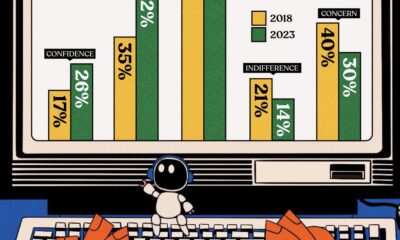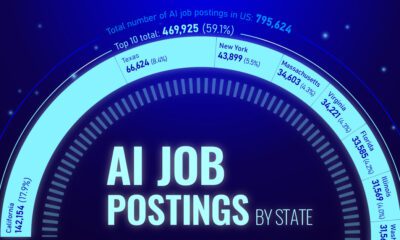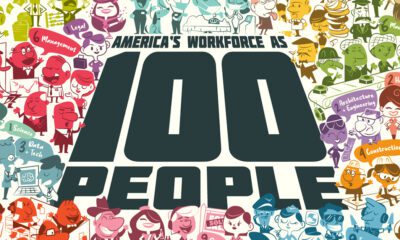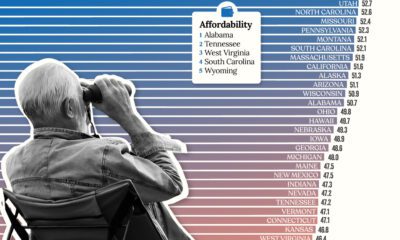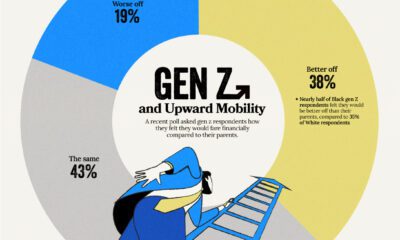Jobs
Visualizing Annual Working Hours in OECD Countries
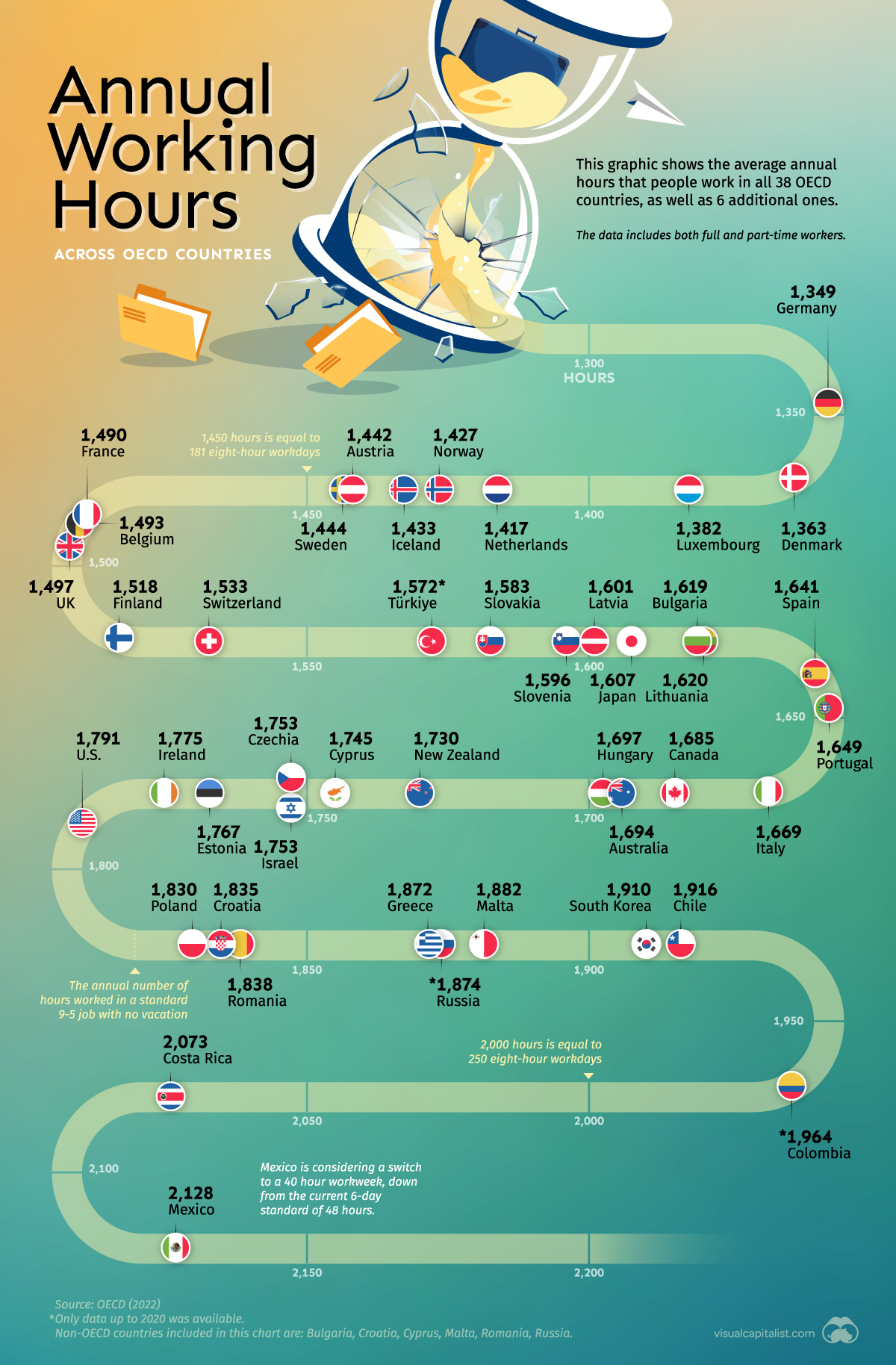
Visualizing Annual Working Hours in OECD Countries
Comparing the number of hours people work in different countries can provide insight into cultural work norms, economic productivity, and even labor laws.
With this in mind, we’ve ranked OECD countries (plus a few others) based on their average annual hours worked. Note that this data includes both full-time and part-time workers.
Data and Highlights
The data we sourced from OECD is listed in the table below. All figures are as of 2021 (latest available), with the exception of Colombia, Russia, and Türkiye which are as of 2020.
| Country | Average annual hours worked |
|---|---|
| 🇲🇽 Mexico | 2,128 |
| 🇨🇷 Costa Rica | 2,073 |
| 🇨🇴 Colombia | 1,964 |
| 🇨🇱 Chile | 1,916 |
| 🇰🇷 South Korea | 1,910 |
| 🇲🇹 Malta* | 1,882 |
| 🇷🇺 Russia* | 1,874 |
| 🇬🇷 Greece | 1,872 |
| 🇷🇴 Romania* | 1,838 |
| 🇭🇷 Croatia* | 1,835 |
| 🇵🇱 Poland | 1,830 |
| 🇺🇸 United States | 1,791 |
| 🇮🇪 Ireland | 1,775 |
| 🇪🇪 Estonia | 1,767 |
| 🇨🇿 Czech Republic | 1,753 |
| 🇮🇱 Israel | 1,753 |
| 🇨🇾 Cyprus* | 1,745 |
| 🇳🇿 New Zealand | 1,730 |
| 🌐 OECD average | 1,716 |
| 🇭🇺 Hungary | 1,697 |
| 🇦🇺 Australia | 1,694 |
| 🇨🇦 Canada | 1,685 |
| 🇮🇹 Italy | 1,669 |
| 🇵🇹 Portugal | 1,649 |
| 🇪🇸 Spain | 1,641 |
| 🇱🇹 Lithuania | 1,620 |
| 🇧🇬 Bulgaria* | 1,619 |
| 🇯🇵 Japan | 1,607 |
| 🇱🇻 Latvia | 1,601 |
| 🇸🇮 Slovenia | 1,596 |
| 🇸🇰 Slovakia | 1,583 |
| 🇹🇷 Türkiye | 1,572 |
| 🇨🇭 Switzerland | 1,533 |
| 🇫🇮 Finland | 1,518 |
| 🇬🇧 United Kingdom | 1,497 |
| 🇧🇪 Belgium | 1,493 |
| 🇫🇷 France | 1,490 |
| 🇸🇪 Sweden | 1,444 |
| 🇦🇹 Austria | 1,442 |
| 🇮🇸 Iceland | 1,433 |
| 🇳🇴 Norway | 1,427 |
| 🇳🇱 Netherlands | 1,417 |
| 🇱🇺 Luxembourg | 1,382 |
| 🇩🇰 Denmark | 1,363 |
| 🇩🇪 Germany | 1,349 |
*Non-OECD country
At the top is Mexico, where the average worker clocks over 2,000 hours per year. This reflects the country’s labor dynamics, which typically involves a six-day workweek. For context, 2,128 hours is equal to 266 eight-hour workdays.
The only other country to surpass 2,000 annual hours worked per worker is Costa Rica, which frequently tops the World Economic Forum’s Happy Planet Index (HPI). The HPI is a measure of wellbeing, life expectancy, and ecological footprint.
Looking at the other end of the list, the two countries that work the fewest hours are Germany and Denmark. This is reflective of the strong labor laws in these countries as well as their emphasis on work-life balance.
For example, the German Working Hours Act (Arbeitszeitgesetz) states that daily hours of work may not exceed eight hours. Days can be extended to 10 hours, but only if it averages out to eight hours per working day over a six-month period.
Working fewer hours doesn’t mean that a country is becoming less productive, though. Germany is known for its high value industries like automotive and pharmaceuticals, where robotics and other technologies can greatly enhance productivity.
This is supported by GDP per capita, in which Germany has grown substantially since 2000.
Limitations of this Data
A limitation of this dataset is that it aggregates both full-time and part-time workers. This means that in a country like Japan, where almost 40% of the workforce is non-regular (part-time, contract, etc.), the average figure could be skewed downwards.
Japan is known for its grueling office culture, and it’s likely that many workers are logging significantly more hours than the 1,607 figure reported.
If you enjoy comparisons like these, consider taking a look at our ranking of cities with the best work-life balance.
Automation
Charted: Changing Sentiments Towards AI in the Workplace
Opinions about using AI in the workplace have undergone a transformation from 2018, and so have the AI tools themselves.
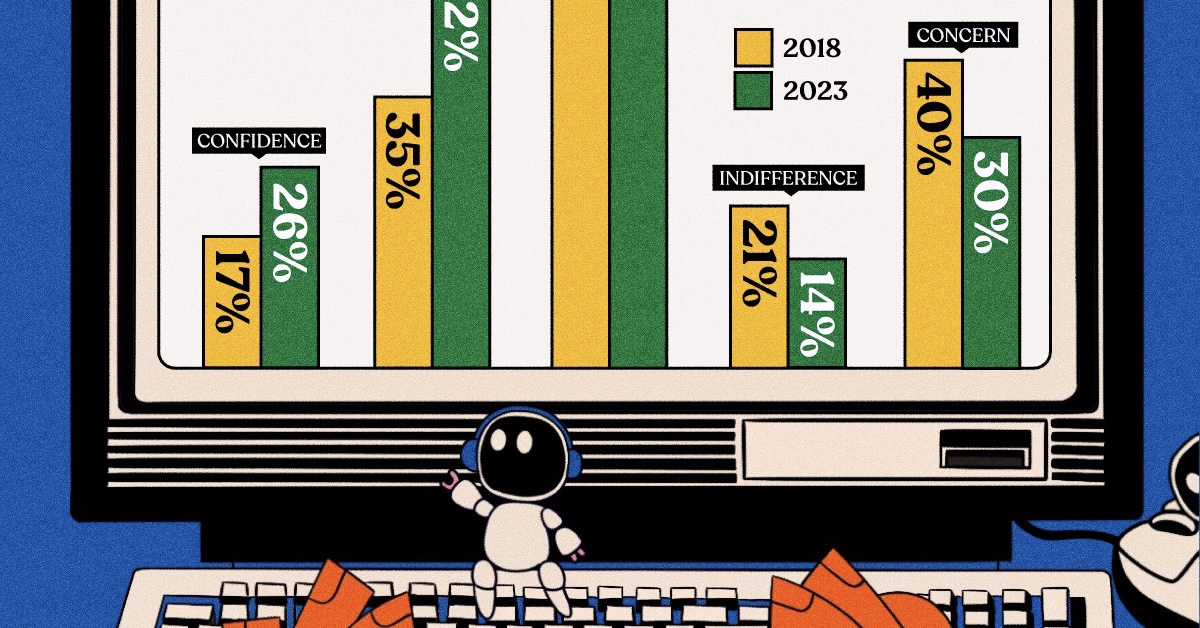
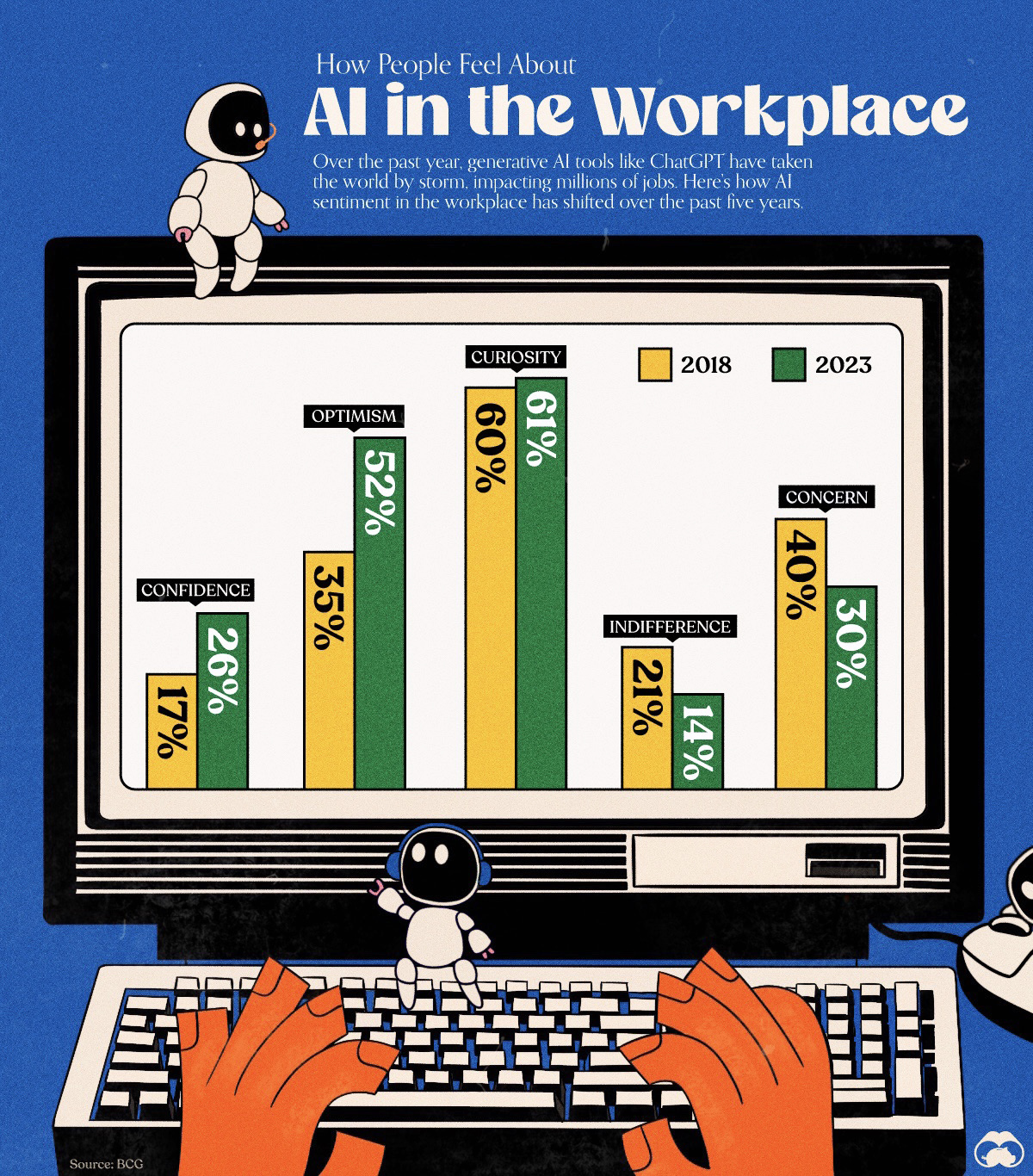
Is generative AI the catalyst for the next industrial revolution? Or is it a flash in the pan? Is the entire workforce destined to become AI makers and managers?
It’s possible that one, all, or none of these options could be correct. But despite how fast large language models (LLMs) and tools have grown the popularity of artificial intelligence, one thing that is clear is that there are no quick or easy answers.
Amidst all this uncertainty, opinions on how we use AI in the workplace have evolved. Recent survey data from Boston Consulting Group (BCG) reveals how the labor force feels about AI in the workplace today, compared to how they felt five years ago.
The consultancy surveyed 13,000 people (C-suite leaders, managers, and frontline employees) in 18 different countries for the results, and divided their top two responses into five categories: Curiosity, Optimism, Concern, Confidence, and Indifference.
More Optimism, Less Caution Around AI
General curiosity about AI remains almost unchanged (at 60%) since 2018.
Meanwhile, despite how rapidly AI has advanced in the last five years, or perhaps because of it, more than 50% of workers surveyed are optimistic about AI’s impact on work, a 17 percentage point (p.p.) increase from 2018.
And though 30% remain concerned about AI, this fell 10 p.p. over the same time period.
| Sentiment towards AI | 2018 | 2023 |
|---|---|---|
| Curiosity | 60% | 61% |
| Optimism | 35% | 52% |
| Concern | 40% | 30% |
| Confidence | 17% | 26% |
| Indifference | 21% | 14% |
Clearly, respondents perceive AI in the workplace far more positively now than they did in 2018. But that’s not all. The respondents’ confidence in how AI can influence their work has also increased (+5 p.p.) and indifference towards it has shrunk significantly (-7 p.p.).
Given the explosive growth in generative AI since the end of 2022—ChatGPT gets 1.8 billion visitors a month—it’s not surprising that workers are far more aware of AI compared to just five years ago.
Optimistic Leaders, Cautious Employees
As with any survey data, the devil is in the details. BCG notes that the sentiments between rungs on the company ladder differ sharply around AI.
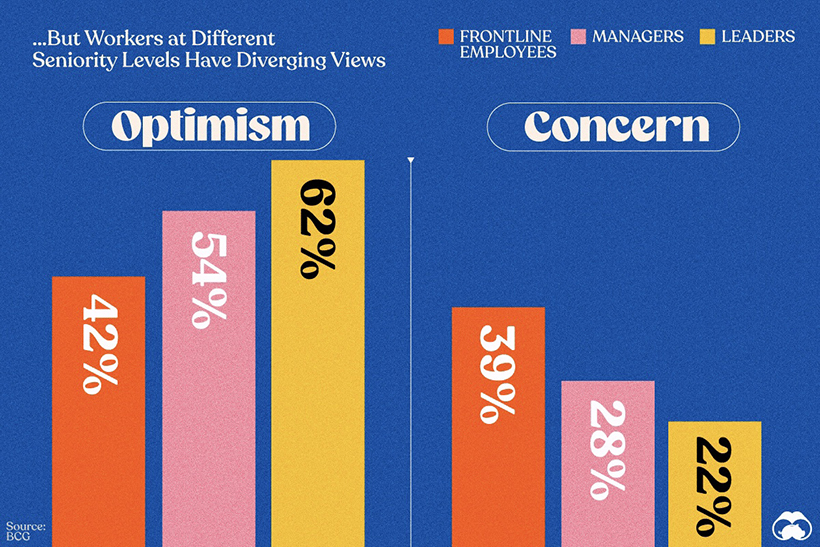
While two-thirds of polled leaders are optimistic about AI in 2023, less than half of polled frontline employees shared the same sentiment. Frontline employees were also the biggest group that responded with concern (nearly 40%).
Importantly, frontline employees are almost as optimistic as they are concerned about AI in the workplace.
| Position | Optimism | Concern |
|---|---|---|
| Leaders | 62% | 22% |
| Managers | 54% | 28% |
| Frontline Employees | 42% | 39% |
Managers were closer to leaders in their AI optimism, though some experts believe their jobs might actually be the most at risk of being replaced all together.
More Use, More Optimism Around AI
With ChatGPT reaching 100 million active users just two months after launching, it’s clear that more and more people are experimenting with generative AI.
In BCG’s poll, regular AI users—categorized as people who use it at least once a week for work—are nearly three times more optimistic than concerned about AI’s impact on their work in 2023.
| AI Use Level | Optimism | Concern |
|---|---|---|
| Regular | 62% | 22% |
| Rare | 55% | 27% |
| None | 36% | 42% |
Even rare users are two times more optimistic than cautious, with the non-user category registering the most concern.
Which brings us to who these regular users are.
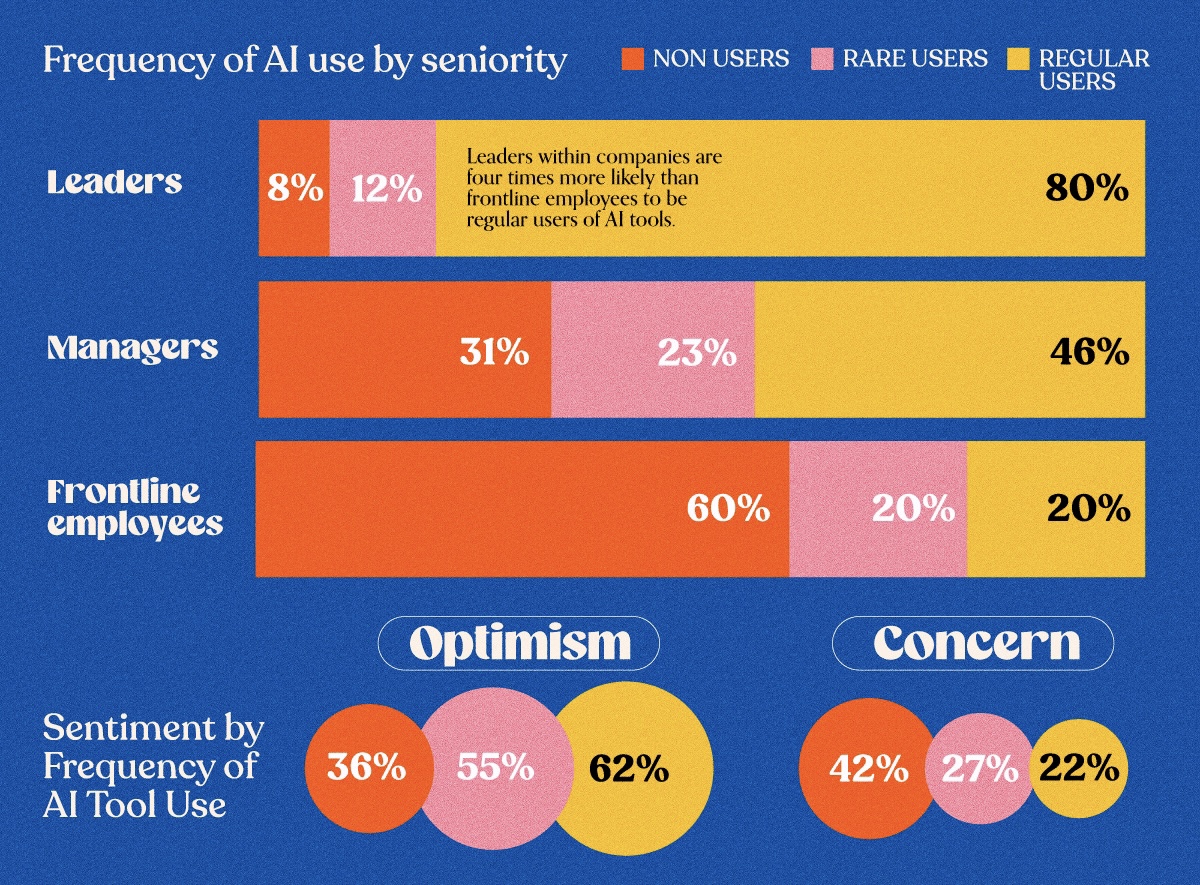
A staggering 80% of the leaders polled say they’re already regular users of AI, compared to 46% managers and 20% frontline employees.
While eyebrow-raising, these figures are not surprising.
People in leadership positions tend to have a mandate to stay ahead of the curve on current business trends, and along with their less strictly defined roles, have more freedom to try, use, and adopt AI tools while they formulate policies for their workplace.
| Position | Regular User | Rare User | Nonuser |
|---|---|---|---|
| Leaders | 80% | 12% | 8% |
| Managers | 46% | 23% | 31% |
| Frontline Employees | 20% | 20% | 60% |
At the same time, AI tools may not be green-lit en masse in many workplaces yet, preventing frontline employees from giving them a go.
So Is AI Coming For Jobs or Not?
Regardless of how definitively one can make a claim about artificial intelligence taking away people’s jobs, the survey respondents were unanimous that AI in the workplace will have some kind of an impact on their employment.
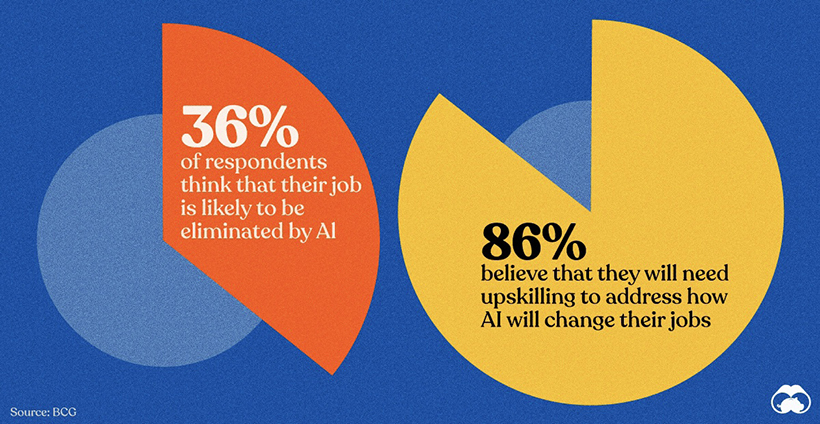
Slightly more than one-third felt that their job is in jeopardy as of 2023, while an overwhelming 86% polled said they needed training to adapt to how AI will transform their work.
With how fast the field is currently transforming, upskilling could be the safest path to follow as the AI revolution unfolds.
Where Does This Data Come From?
Source: The AI at Work: What People Are Saying report from the Boston Consulting Group.
-

 Markets4 weeks ago
Markets4 weeks agoThe World’s Biggest Mutual Fund and ETF Providers
-

 Brands2 weeks ago
Brands2 weeks agoBrand Reputations: Ranking the Best and Worst in 2023
-

 Environment5 days ago
Environment5 days agoHotter Than Ever: 2023 Sets New Global Temperature Records
-

 Datastream4 weeks ago
Datastream4 weeks agoCan You Calculate Your Daily Carbon Footprint?
-

 Energy2 weeks ago
Energy2 weeks agoWho’s Still Buying Russian Fossil Fuels in 2023?
-

 VC+4 days ago
VC+4 days agoWhat’s New on VC+ in July
-

 Investor Education4 weeks ago
Investor Education4 weeks agoVisualizing BlackRock’s Top Equity Holdings
-

 apps2 weeks ago
apps2 weeks agoMeet the Competing Apps Battling for Twitter’s Market Share


